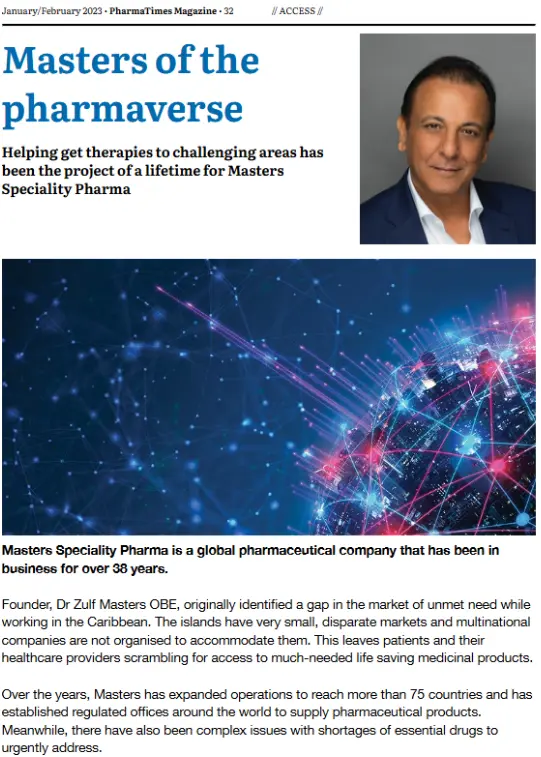News
Pharma Times: Masters of the Pharmaverse

Helping get therapies to challenging areas has been the project of a lifetime for Masters Speciality Pharma
Masters Speciality Pharma is a global pharmaceutical company that has been in business for over 38 years. Founder, Dr Zulf Masters OBE, originally identified a gap in the market of unmet need while working in the Caribbean.
The islands have very small, disparate markets and multinational companies are not organised to accommodate them. This leaves patients and their healthcare providers scrambling for access to much needed lifesaving medicinal products. Over the years, Masters has expanded operations to reach more than 75 countries and have established regulated offices around the world to supply pharmaceutical products. Meanwhile, there has also been complex issues with shortages of essential drugs to urgently address. Nevertheless, the company decided to adapt a strategy in transforming the organisation and skills to match those of a speciality pharmaceutical company in a changing world.
Altered states
Pharmaceutical product shortages are now a world-wide problem, especially amid the pandemic. Where Masters does not have local presence, they have a network of distribution partners which can help. Several of the markets Masters provides for are subject to unpredictable changes – political, financial and constitutional. As these countries evolve, regulations are becoming increasingly sophisticated, often implementing cost containment and localisation measures. Providing excellence in service to healthcare providers in emerging markets with trust in the integrity of product through quality assurance is the essence of good business. Masters is continuously monitoring service levels and improving processes to get a competitive advantage. Nevertheless, the company decided to adapt a strategy in transforming the organisation and skills to match those of a speciality pharmaceutical company in a changing world.
Change makers
The journey began five years ago by embarking on a restructuring program. The first step in transforming the legacy business of international wholesaling into a global specialty pharma company was focusing on the offer of unique and specialised products. Ultimately, it was important to look at the needs of the global market through a different lens. Nevertheless, the company decided to adapt a strategy in transforming the organisation and skills to match those of a speciality pharmaceutical company in a changing world. Business development activities started with analysing the competitor landscape. Success lay in adapting to trends across industry and appreciating the different regulations in different countries. The next step was to invest in the development of a higher-value products portfolio. Masters targeted a range which included both small and large molecules, high
Masters Speciality Pharma is a global pharmaceutical company that has been in business for over 38 years. Founder, Dr Zulf Masters OBE, originally identified a gap in the market of unmet need while working in the Caribbean.
The islands have very small, disparate markets and multinational companies are not organised to accommodate them. This leaves patients and their healthcare providers scrambling for access to much needed lifesaving medicinal products. Over the years, Masters has expanded operations to reach more than 75 countries and have established regulated offices around the world to supply pharmaceutical products. Meanwhile, there has also been complex issues with shortages of essential drugs to urgently address. Nevertheless, the company decided to adapt a strategy in transforming the organisation and skills to match those of a speciality pharmaceutical company in a changing world.
Altered states
Pharmaceutical product shortages are now a world-wide problem, especially amid the pandemic. Where Masters does not have local presence, they have a network of distribution partners which can help. Several of the markets Masters provides for are subject to unpredictable changes – political, financial and constitutional. As these countries evolve, regulations are becoming increasingly sophisticated, often implementing cost containment and localisation measures. Providing excellence in service to healthcare providers in emerging markets with trust in the integrity of product through quality assurance is the essence of good business. Masters is continuously monitoring service levels and improving processes to get a competitive advantage. Nevertheless, the company decided to adapt a strategy in transforming the organisation and skills to match those of a speciality pharmaceutical company in a changing world.
Change makers
The journey began five years ago by embarking on a restructuring program. The first step in transforming the legacy business of international wholesaling into a global specialty pharma company was focusing on the offer of unique and specialised products. Ultimately, it was important to look at the needs of the global market through a different lens. Nevertheless, the company decided to adapt a strategy in transforming the organisation and skills to match those of a speciality pharmaceutical company in a changing world. Business development activities started with analysing the competitor landscape. Success lay in adapting to trends across industry and appreciating the different regulations in different countries. The next step was to invest in the development of a higher-value products portfolio. Masters targeted a range which included both small and large molecules, high
quality generic and branded drugs, as well as orphan drugs. Essentially, a selection of products that offered specialised treatments that were not available locally. The company invested in an infrastructure of people to comprehend the diseases and the patient journey.
Market forces
Marketing and sales strategies were developed through relationships with relevant stakeholders and healthcare providers, such as physicians, hospitals, specialist disease centres and patient advocacy groups. These pivotal relationships provided the necessary insight into different markets, helping the company better understand the demands in different countries.
Specialised marketing strategies were consequently designed for different countries, like use of e-commerce platforms, special promotional programs and collaborations with medical practitioners. The company also built intelligence regarding any local reimbursement and health technology assessment requirements. This meant that expert, country-specific regulatory insight into the market access process was aligned before launching the drug. Ultimately, it was vital that a proactive approach to safeguarding the supply chain and products was embraced. This included adopting sound supply chain management practices, investing in technology and staff, as well as complying with standards applicable to the company’s global operation. Looking to the future, the key to success is continuing to evolve, ensuring that the demands of a constantly changing pharma industry are always met.
Read the full article here or visit our website’s ‘What we do’ page here.
Market forces
Marketing and sales strategies were developed through relationships with relevant stakeholders and healthcare providers, such as physicians, hospitals, specialist disease centres and patient advocacy groups. These pivotal relationships provided the necessary insight into different markets, helping the company better understand the demands in different countries.
Specialised marketing strategies were consequently designed for different countries, like use of e-commerce platforms, special promotional programs and collaborations with medical practitioners. The company also built intelligence regarding any local reimbursement and health technology assessment requirements. This meant that expert, country-specific regulatory insight into the market access process was aligned before launching the drug. Ultimately, it was vital that a proactive approach to safeguarding the supply chain and products was embraced. This included adopting sound supply chain management practices, investing in technology and staff, as well as complying with standards applicable to the company’s global operation. Looking to the future, the key to success is continuing to evolve, ensuring that the demands of a constantly changing pharma industry are always met.
Read the full article here or visit our website’s ‘What we do’ page here.


